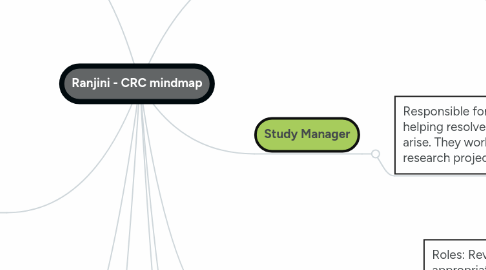
1. Study Site
2. Investigator (Physician)
2.1. Roles: Conducting the trial, leading the research team, study protocol design and amendments, ensuring and monitoring subject/participant safety.
2.1.1. Communication involved is verbal (study initiation and update meetings (1:1/group - teleconferences/ face-face meetings, discussions)), non-verbal (body language, gestures, handshakes and eye contacts), written (emails, reports, forms, official documents such as protocol, protocol amendments, adverse event reports) and visual (presentations, charts, tables)
3. Research Team (Research Nurse/Research Pharmacist/ Research Assistant/Tech)
3.1. Roles: Consents eligible participants, completes assessments on study participants, administer study drugs/treatment interventions, obtains study samples, reports side-effects or adverse events, completes participant compliance reports, managing study drug, maintaining IND supplies at site pharmacy.
3.1.1. Communication regarding study participants, adverse events, participant-assessments, study protocol updates or deviation, participant compliance, ordering/refilling medication etc., is verbal (teleconferences, in-person 1:1/group discussions), non-verbal (body language, gestures, handshakes and eye contacts), written (emails, reports, forms) and visual – (presentations, charts, tables, data representations).
4. Data Manager
4.1. Collect data required for the clinical trial which may include reviewing patients medical records. Also responsible for addressing any questions from the study sponsor concerning the data.
4.1.1. Communication involved is verbal (study update through telephone/in-person meetings), written (data collection reports, data deviations), visual (presentation of data collection trends, charts, tables), non-verbal (body language, gestures, handshakes, facial expressions).
5. Patients (& patients' families)
5.1. Roles: Patients would learn and make aware through constant patient education of current protocol any amendments and treatment interventions, they would also provide their consent to participate in the study, learn about checkpoint diagnostic assessments, allow for data collection and medical reports, etc.
5.1.1. Communication involved is verbal (in-person/telephonic patient screening interviews for study inclusion/exclusion, explaining the study, treatment intervention, underlying pathophysiological management of disease state, etc.), non-verbal (body language, gestures, handshakes, eye contact), written (emails, consent forms, information sheets), and visual (study flyers, explaining the procedure and their participation using images, charts).
6. Sponsor Site
7. Clinical Research Project Manager
7.1. Roles: Primary point of contact from sponsor-side for study investigator and research coordinator. Responsible for setting up and supporting the study site and reviewing the study protocol with the staff. Supports study sites to ensures all appropriate study documentations are up-to-date and compliant.They work closely with the study manager.
7.1.1. Communication involved is verbal (regular telephonic and in-person meetings to discuss study protocol updates, financial status and updates), non-verbal (body language, gestures, handshakes, eye contact), written (email updates, financial forms, reports, agreements etc), and visual (presentations, charts, data representations, tables and projections).
8. Study Manager
8.1. Responsible for overseeing the trial and helping resolve any issues that may arise. They work closely with clinical research project manager.
8.1.1. Communication involved is verbal (telephonic or in-person meetings), written communication (emails, study protocol updates, financial forms, agreements), non-verbal (body language, gestures, handshakes, facial expressions) and visual (charts, presentations and tables).
9. df
10. Regulatory Authorities (FDA/Health Canada)
10.1. Roles: Review appropriate documentation, application and reports, conduct audits and inspections.
10.1.1. Communication involved is written (emails, drug safety profile, toxicity reports, investigational drug applications, study compliance etc.).
11. Independent Ethics Board (Research Ethics Board/Institutional Review Board)
11.1. Roles: To monitor and ensure protocol follows and complies with Good Clinical Practice and patient/participant safety and confidentiality, reviews participant recruitment and study protocols and regulatory material.
11.1.1. Communication involved is verbal (telephonic questions, meetings), written (ethics applications – initial, continued with any amendments and study close-out, inquiry emails, forms and reports), and visual (charts, tables and data collection representations).
12. Data and Safety Monitoring Board
12.1. Roles: Periodic review & evaluation of accumulated study data for participant safety, confidentiality, study conduct progress & efficacy.
12.1.1. Communication involved is verbal (during audits, and inspection), written (data safety monitoring reports and explanations, emails, application, study data), visual (charts, tables, data collection flow-charts).
